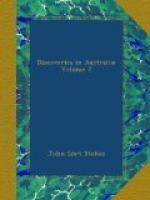During the summer, or from the early part of October to the beginning of April, they are almost constant from this quarter; but in the winter their regularity is broken in upon by occasional winds between north and west that at times blow with great violence, and are accompanied by heavy rain, and thick dirty weather.
Near the shore, land and seabreezes appear to be regular, the former generally dying away towards the middle of the day, after having reached as far as East from about South-East at sunrise; then follows a short interval of calm, after which, the seabreeze sets in, mostly at South-South-West, and draws to the eastward of south in the evening.
At times the land wind veers round the compass, and is then generally stronger than usual; blowing fresh for a short time from North-East, and bringing a parching heat from the land; upon these occasions the seabreeze comes in from a more western point, and is lighter.
At Swan River, in the months of December, January, and February, the seabreezes are very strong, for intervals of from three to five days; during which time they blow fresh throughout the night—drawing to the southward after midnight, and towards sunrise to South-South-East and South-East, but more moderate. In the middle of the day, they back again to the southward, and soon to South-South-West, from which quarter they blow very fresh until midnight.
Intervals of such weather are from three to five days’ duration, and are followed by the like number of days of moderate weather, with winds mostly off the land; sometimes strong gusts from the east, for a few hours, with oppressively hot weather.
I have noticed, that when the seabreeze sets in from a point to the westward of South-West, it does not blow so strong, and generally lulls at sunset; but if more southerly, or from South-South-West, it is a fiery breeze, and often lasts until midnight.
During the prevalence of these strong seabreezes, communication between Gage Road and the shore is very inconvenient—particularly for laden boats.
In March, the seabreezes are not nearly so strong, but are generally moderate, and not unfrequently bring in thick misty weather from southwards, with drizzling rain.
Generally speaking, when the seabreezes are the strongest, the land winds are light, and vice versa.
I cannot speak from experience of the winds or weather during the month of April, at Swan River, but have been told that the seabreezes are moderate, and the land winds of longer duration; calms are frequent—and the weather altogether seems to indicate the breaking up of the summer season; light winds are occasionally felt from the northward, with a dull, gloomy appearance between that point and South-West.




